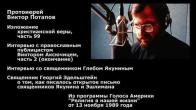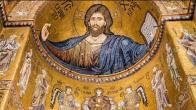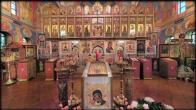You are here
Hieromartyr Clement, pope of Rome
25 November/8 December
 Hieromartyr Clement, Pope of Rome, was born in Rome into a wealthy and distinguished family. Separated by force of circumstances from his parents from childhood, Clement was brought up by strangers. Living in Rome, the youth received an excellent education, was surrounded by luxury and was close to the imperial court. But pleasures did not gladden him; pagan wisdom did not allure him. He began to ponder on the meaning of life. When tidings of Christ and His teaching reached the capital, Saint Clement left his home and possessions and set out for those places and those lands where the Apostles were preaching. In Alexandria, Clement met the holy Apostle Barnabas, to whose words he listened with profound attention, accepting the power and truth of God's Word with all his heart.
Hieromartyr Clement, Pope of Rome, was born in Rome into a wealthy and distinguished family. Separated by force of circumstances from his parents from childhood, Clement was brought up by strangers. Living in Rome, the youth received an excellent education, was surrounded by luxury and was close to the imperial court. But pleasures did not gladden him; pagan wisdom did not allure him. He began to ponder on the meaning of life. When tidings of Christ and His teaching reached the capital, Saint Clement left his home and possessions and set out for those places and those lands where the Apostles were preaching. In Alexandria, Clement met the holy Apostle Barnabas, to whose words he listened with profound attention, accepting the power and truth of God's Word with all his heart.
Having arrived in Palestine, Saint Clement received Baptism from the holy Apostle Peter and became his zealous disciple and constant companion, sharing with him his labors and sufferings. Not long before his passion, the holy Apostle Peter ordained Saint Clement as bishop of the city of Rome. After the death of the Apostle, and after him of Saint Linus, the Bishop of Rome (6779), and his successor, the holy Bishop Anacletus (7991), Saint Clement was on the Roman cathedra (from the year 91 to 101).
The holy Pope Clement's virtuous life, mercifulness and struggle in prayer converted many to Christ. Thus, once, on the day of Pascha, 424 people were baptized all at once by him. Among the baptized were people of all estates: slaves, rulers, members of the imperial family.
The pagans, on seeing the successes of his apostolic preaching, informed against Hierarch Clement to the Emperor Trajan (98117), accusing the saint of blaspheming the pagan gods. The emperor exiled Saint Clement from the capital, sending him to the Crimea, to work in the Inkerman quarries not far from the city of Cherson. Many of the hierarch's disciples followed after him, preferring voluntary exile to separation from their spiritual father. Having arrived at the place of exile, Saint Clement met many faithful Christians who were condemned to work under difficult conditions, completely without water. He prayed together with the condemned, and the Lord in the form of a Lamb revealed to him the site of a spring, from which a whole river poured forth. This wonder attracted a multitude of people to Hierarch Clement. By listening to the zealous preacher, hundreds of pagans were converted to Christ. Each day 500 and more people would be baptized. And there, in the quarries, a church was hewn out, in which he performed the sacred rites.
The saint's apostolic activity provoked the wrath of the Emperor Trajan, and he ordered that Saint Clement be drowned. They cast the martyr into the sea with an anchor around his neck. This took place in the year 101.
By the prayers of the hierarch's faithful disciples, Cornelius and Phoebus, and of all the people, the sea receded, and on the bottom the people found the incorrupt body of their pastor in a church notmadebyhands ("the Angelic Church"). After this, every year on the day of Hierarch Clement's martyric end the sea would recede, and in the course of seven days the Christians were able to venerate his holy relics. Only in the ninth century, during the reign of the Constantinopolitan Emperor Nicephorus (802811), by God's allowance, did the relics of Saint Clement become inaccessible for veneration for fifty years. Under the Emperor Michael and his mother, Theodora (855867), Cyril and Methodius, the equals of the Apostles, visited Cherson. Having learned of Saint Clement's hidden relics, they roused the bishop of Cherson, George, to collective prayer to the Lord concerning the discovery of the hieromartyr's relics. After a collective service by Saints Cyril and Methodius and the clergy who had arrived with them from the Imperial City and the fervent prayer of all who had gathered, the holy relics of Bishop Clement miraculously appeared on the surface of the sea, at midnight. They solemnly translated them to the city, to the Church of the Holy Apostles. A part of the relics was translated by Saints Cyril and Methodius to Rome, and his holy head was subsequently translated to Kiev by the holy Prince Vladimir, the equal of the Apostles (+1015), and placed in the Tithe Church together with the relics of Saint Phaebus, where a sidechapel was built in Saint Clement's name.
Hierarch Clement, who is regarded as one of the apostolic men, left us a spiritual legacy two epistles to the Corinthians the first literary monuments of Christian teaching after the writings of the holy Apostles.
Relics in cathedral - monthly calendar
| S | M | T | W | T | F | S |
|---|---|---|---|---|---|---|
|
1
|
2
|
3
|
4
|
5
|
6
|
7
|
|
8
|
9
|
10
|
11
|
12
|
13
|
14
|
|
15
|
16
|
17
|
18
|
19
|
20
|
21
|
|
22
|
23
|
24
|
25
|
26
|
27
|
28
|
|
29
|
30
|
31
|
|
|
|
|
PARISH LIFE
Address of our Cathedral
While all the materials on this site are copyrighted, you may use them freely as long as you treat them
with respect and provide attribution on the Russian Orthodox Cathedral of St.John the Baptist of Washington DC.









